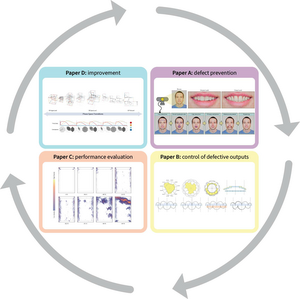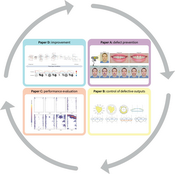Information
- Publication Type: PhD-Thesis
- Workgroup(s)/Project(s):
- Date: 2021
- Date (Start): 2014
- Date (End): 2021
- TU Wien Library:
- Second Supervisor:
- Open Access: yes
- 1st Reviewer: Ingrid Hotz
- 2nd Reviewer: Bernhard Preim
- Rigorosum: 18. October 2021
- First Supervisor: Eduard Gröller
- Pages: 178
- Keywords: visualization, visual analytics, defect analysis, dentistry, material science, mathematical visualization
Abstract
In everyday life, we use many objects on which we rely and expect them to work correctly. We use phones to communicate with friends, bicycles to commute, payment cards to buy groceries. However, due to defects, these objects may fail at some time, leading to adverse outcomes. Modern industry continually improves the quality of outputs (e.g., products and services) and ensures that they meet their specifications. A common quality management strategy is the defect analysis used to identify and control outputs that do not conform to their specifications. Traditional defect analysis methods are often manual and, therefore, time-consuming procedures. To build more efficient solutions, defect analysis increasingly employs visual analytics techniques. These techniques automatize and enhance the up-to-now manual analysis steps and support new visual approaches for defect representations that resolve existing defects without introducing new ones. In this dissertation, visual analytics techniques applied to defect analysis are referred to as visual analysis of defects. Being a rapidly developing area, the domain of visual analysis of defects is still missing a formalized basis.This dissertation presents and discusses a workflow for the visual analysis of defects based on the plan-do-check-act cycle of continual improvement. The workflow consists of four steps: defect prevention, control of defective outputs, performance evaluation, and improvement. During the defect prevention step, domain experts plan the design and development processes to ensure that intended results can be achieved while forecasting risks and opportunities. During the control of defective outputs step, domain experts implement the processes and control defects arising throughout these processes. During the performance evaluation step, domain experts ensure that defective outputs are identified by measuring the object's characteristics. During the improvement step, domain experts explore possible actions that improve the object quality.
This dissertation presents four solutions that advance the visual analysis of defects at the four distinct steps of the workflow. The first solution corresponds to the defect prevention step and provides a preview of dental treatment. It helps dental technicians to identify the most suitable treatment option and avoid cases when patients are unsatisfied with the results due to poor denture aesthetics. The second solution corresponds to the control of defective outputs step and supports dental technicians in designing aesthetic and functional dentures. The approach provides immediate visual feedback on a change in the denture design, which helps to evaluate how the change affects aesthetics. The third solution corresponds to the performance evaluation step and supports material engineers in investigating the damage mechanism in composite materials. First, the system captures and measures various defects such as matrix fracture, fiber/matrix debonding, fiber pull-out, and fiber fracture. Later, users analyze these defects using several interactive visualization techniques. The fourth solution corresponds to the improvement step and visualizes 4D dynamical systems describing various phenomena. The solution enables the 4D representation of dynamical systems and allows the 4D representation to seamlessly transition into, familiar to the user, lower-dimensional plots.
Additional Files and Images
Weblinks
- Entry in reposiTUm (TU Wien Publication Database)
- Entry in the publication database of TU-Wien
- DOI: 10.34726/hss.2022.99023
BibTeX
@phdthesis{amirkhanov-2021-diss,
title = "Visual Analysis of Defects",
author = "Aleksandr Amirkhanov",
year = "2021",
abstract = "In everyday life, we use many objects on which we rely and
expect them to work correctly. We use phones to communicate
with friends, bicycles to commute, payment cards to buy
groceries. However, due to defects, these objects may fail
at some time, leading to adverse outcomes. Modern industry
continually improves the quality of outputs (e.g., products
and services) and ensures that they meet their
specifications. A common quality management strategy is the
defect analysis used to identify and control outputs that do
not conform to their specifications. Traditional defect
analysis methods are often manual and, therefore,
time-consuming procedures. To build more efficient
solutions, defect analysis increasingly employs visual
analytics techniques. These techniques automatize and
enhance the up-to-now manual analysis steps and support new
visual approaches for defect representations that resolve
existing defects without introducing new ones. In this
dissertation, visual analytics techniques applied to defect
analysis are referred to as visual analysis of defects.
Being a rapidly developing area, the domain of visual
analysis of defects is still missing a formalized basis.
This dissertation presents and discusses a workflow for the
visual analysis of defects based on the plan-do-check-act
cycle of continual improvement. The workflow consists of
four steps: defect prevention, control of defective outputs,
performance evaluation, and improvement. During the defect
prevention step, domain experts plan the design and
development processes to ensure that intended results can be
achieved while forecasting risks and opportunities. During
the control of defective outputs step, domain experts
implement the processes and control defects arising
throughout these processes. During the performance
evaluation step, domain experts ensure that defective
outputs are identified by measuring the object's
characteristics. During the improvement step, domain experts
explore possible actions that improve the object quality.
This dissertation presents four solutions that advance the
visual analysis of defects at the four distinct steps of the
workflow. The first solution corresponds to the defect
prevention step and provides a preview of dental treatment.
It helps dental technicians to identify the most suitable
treatment option and avoid cases when patients are
unsatisfied with the results due to poor denture aesthetics.
The second solution corresponds to the control of defective
outputs step and supports dental technicians in designing
aesthetic and functional dentures. The approach provides
immediate visual feedback on a change in the denture design,
which helps to evaluate how the change affects aesthetics.
The third solution corresponds to the performance evaluation
step and supports material engineers in investigating the
damage mechanism in composite materials. First, the system
captures and measures various defects such as matrix
fracture, fiber/matrix debonding, fiber pull-out, and fiber
fracture. Later, users analyze these defects using several
interactive visualization techniques. The fourth solution
corresponds to the improvement step and visualizes 4D
dynamical systems describing various phenomena. The solution
enables the 4D representation of dynamical systems and
allows the 4D representation to seamlessly transition into,
familiar to the user, lower-dimensional plots.",
pages = "178",
address = "Favoritenstrasse 9-11/E193-02, A-1040 Vienna, Austria",
school = "Research Unit of Computer Graphics, Institute of Visual
Computing and Human-Centered Technology, Faculty of
Informatics, TU Wien ",
keywords = "visualization, visual analytics, defect analysis, dentistry,
material science, mathematical visualization",
URL = "https://www.cg.tuwien.ac.at/research/publications/2021/amirkhanov-2021-diss/",
}



